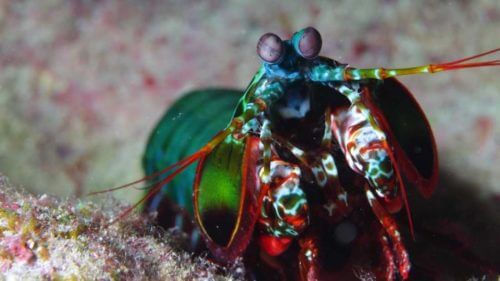The mantis eye has tripartite vision, which means that every object is observed in all three parts of the eye at the same time. This structure enables serial and parallel processing of visual stimuli

By: Dafna Haim Langford
The mantis mantis, the "fist" as it is sometimes called, is a relatively large mantis, reaching a length of about 30 cm and living on the seabed in the tropics. Known for his great aggressiveness and strength, this Hasilon is known mainly for his projectile-strong fists, with which he attacks his victims.
In this article we will deal specifically with the colored eyes of the mantis, which are considered the most sophisticated in the animal kingdom, which enable the mantis to have complex vision. The mantis eye has tripartite vision, which means that every object is observed in all three parts of the eye at the same time. This structure enables serial and parallel processing of visual stimuli.
What's more: while humans only have 5 visual pigments and no ability to detect polarized light, the peacock mantis is able to see both visible light, UV light and polarized light. It is endowed with 16 types of photoreceptors (light receptors), of which 12 are used for color vision and four are used for analyzing polarized light. (Polarized light is an electromagnetic wave with a definite polarization; this is in contrast to unpolarized light, such as sunlight, which consists of a collection of waves with different polarization directions, so that the direction of the considered field changes randomly.) This miraculous sight allows the mantis to escape from the shiny barracuda, to find the prey His with great precision, and of course to receive courtship messages - in the appropriate high tide season - by detecting the moonlight.
At the University of Queensland in Australia, they hope to imitate the wonderful visual abilities of the mantis to measure brain activity and diagnose cancerous tumors. Cancerous tissues are known to reflect polarized light differently than healthy tissues, so various imaging systems use this fact to diagnose cancerous tumors. The researchers hope to improve existing imaging technologies by mimicking elements in the mantis eye. Indeed, the video camera developed in collaboration with scientists from the USA and England and inspired by the eye of the mantis, enables the diagnosis of malignancy in real time, as well as the reading of the electrical activity of nerve cells. In fact, the camera converts invisible signals into colors.
Precise sensors are important for the development of medical devices in the field of oncology because they reduce the need for invasive tests such as biopsies, and can improve the level of accuracy during surgeries to remove tumors. In addition, some of the known imaging methods can only diagnose certain types of cancer, so there is room for improvement. Recently, the researchers demonstrated their ability to detect cancerous tumors in mice using fluorescent diagnostics combined with polarized light.
In the future, will our smartphone camera allow us to self-diagnose cancerous tumors? time will tell.
